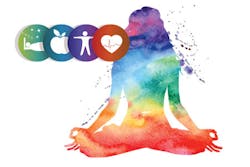By Dorothy Garlough, RDH, MPA
Yoga has been a regular practice in my life for 40 years. In the early days, there were no studios, classes, or retreats. It hadn’t become popular yet, and some of my colleagues considered me “way out there.” Why would I want to contort my body, focus on my breath, and learn to meditate? Why would I study a philosophy that focuses on mindfulness and living in the moment? Why would I aspire to be calmly active and actively calm? As it turns out, I wasn’t as odd as some thought. Yoga is now a $27 billion industry,1 and with 37 million people practicing yoga in the US today.2 I was simply an early adopter.
My discovery of yoga came about by happenstance when I read a book entitled “Autobiography of a Yogi” by Paramahansa Yogananda. Upon learning of this 5,000-year-old practice,3 I became curious about its philosophy and was open to trying it. It wasn’t long before I experienced its benefits, both physically and mentally.
Working as a clinical hygienist was exacting a price on my body. My shoulders and neck were feeling progressively sore and the nagging pain in my lower back was not receding. My hips were bothering me and I knew that I was holding tension in my TMJ as well. I had been working for a only few years, and I was concerned that my body would not sustain itself in dentistry over the long haul. My career was at risk and I needed to take action.
The asanas (poses) of yoga were helpful in easing my discomfort. Practicing the poses slowly and gently while always listening to my body, and stretching to the point of resistance but never pain, relieved the strain. My strength and flexibility improved dramatically as I counteracted the natural shortening of muscles, blood vessels, veins, and connective tissue that was occurring because of clinical working positions. Over time, I became pain free and attribute working comfortably as a clinician for over a quarter of a century to having adopted yoga early on.
Medical benefits
Science today supports what I inherently suspected at that time. Yoga is good for the body! One study funded by the National Center for Complementary and Integrated Health shows that yoga can reduce symptoms of chronic back pain. Twelve weekly yoga classes helped patients to function better than those receiving traditional care. Also, the American Osteopathic Association promotes yoga to help increase muscle tone, improve respiration, balance metabolism, improve circulation, reduce weight, and increase energy and vitality.
Dr. Natalie Nevins, director of clinical education at Western University of Health Sciences says, “The relaxation techniques incorporated in yoga can lessen chronic pain, such as lower back pain, arthritis, headaches, and carpal tunnel syndrome. Yoga can also lower blood pressure and reduce insomnia.”
Doctors of osteopathic medicine (DOs) receive extensive training in the musculoskeletal system, the body’s interconnected system of nerves, muscles, and bones. This leads to a greater understanding of how one part of the body can affect the other. DOs look at patients as “whole persons” (just as yoga does) by viewing the body as an integrated whole - body, mind, and spirit.5 Their focus is similar to dentistry in that it focuses on the prevention of disease.
Other studies show yoga can help lower blood pressure in people who have hypertension. It helps to restore “baroreceptor sensitivity,” which helps the body sense imbalances in blood pressure and maintain balance.6 Additionally, coronary artery-diseased patients experience an improved lipid profile when they incorporate yoga as a regular practice. The deep breathing and focus required in yoga relaxes both the body and the mind, resulting in stress reduction. Today, yoga is included in many cardiac rehabilitation programs.7 Its benefits improve not only cardiac health, but also blood sugar levels in people with noninsulin-dependent diabetes. In some people, medications can be reduced.
Yoga improves medical conditions on other fronts as well, such as depression and arthritis, and it’s been shown to improve survival from cancer.7
Other benefits
Another reason for yoga’s popularity today, especially among young people, is the resulting esthetics on the body. Sculpting of the body, muscle definition, and toning are natural outcomes when challenging poses are practiced over time. Some yoga positions can be difficult, and certain vinyasas (sequences of poses) can increase cardiovascular output.
People of all ages gain stamina with yoga, and yoga’s weight-bearing poses can help safeguard against osteoporosis. This is especially beneficial to women as they age. A good instructor will encourage students to tailor their practice to their personal needs. Yoga is always an invitation to your body, not a demand. The general rule is to meet the pose with a steady mind and full breath while challenging the body to push against the wall of resistance without blasting through it.
A fit body is only part of yoga’s attraction. It attracts people of all ages, with classes including people from ages five to 90, and every person benefits. Some people practice yoga their entire lives, and the trend today is to introduce children at young ages. Schools are beginning to incorporate yoga in the classroom with the hope of providing children with a tool to manage anxiety and stress.9
As I’ve mentioned, I’ve experienced yoga’s tranquil effects firsthand. In the early years of practice, I was under intense stress due to an unhealthy marriage. I needed a way to “find my calm.” As I reached the pinnacle of pain, I became a single mom raising two sons. My closest family member was 900 miles away, and I was finding it hard to stay focused. I felt increasingly anxious about the perceived helplessness and hopelessness of my situation. No doubt I would have been diagnosed as clinically depressed at the time, but I did not seek professional help, and right or wrong, medication has always been my last resort.
Yoga offered a space to turn worries off, breathe, slow down, and be present. It was my sanctuary. The time I set aside daily for my yoga practice became sacred as I navigated to an oasis of calm, enabling me to meet my challenges in a balanced and effective manner. By the time the strain eased, yoga had become a well-engrained habit and I had become an advocate of the practice.
My passion for yoga has led me to becoming an instructor. Today my goal is to enable my students not just to practice yoga, but also to experience it. Getting into the zone of the mind/body/spirit connection is not only healthy, it is also empowering. By linking the body through exercise and the mind through “innercise,” we become more centered, grounded, and confident. It has been my experience both as an instructor and student that from this place of peacefulness, kindness and empathy rise.
Curiosity sparked me to research what happens to our brains when we slow down and find stillness. What happens when we allow the breath to become the anchor of the mind? What happens when we allow our bodies to sink into the mat and let go, halting anxiety and worry? See the sidebar for some of the answers.
Science today recognizes the limits of the body and conventional medicine and is heralding yoga as an adjunct to rehabilitation. Even the Mayo Clinic and Harvard’s Clinical Research Institute are promoting yoga as a complementary therapy, with evidence supporting yoga’s ability to reenergize, improve physical and mental fitness, and enhance quality of life. It is also promoted for specific health reasons. The Mayo Clinic has created a video that educates its patients about yoga and leads them through 30 minutes of yoga, meditation, or guided imagery.
Dr. Brent Bauer, the director of the Mayo Clinic of Complementary and Integrative Medicine program, strongly supports yoga and other alternative modalities, yet he is clear that yoga is not the answer for all that ails us. If you want to know if yoga is right for you, ask your doctor.
Reset of internal navigation system
The meaning of the word yoga is to yoke, or unite. Its purpose is to create strength, awareness, and harmony in the mind and the body. It promotes the body’s ability to heal itself, and it believes that balance of the mind is important. Learning to train our thoughts helps us step away from challenges in life and allows us to meet tasks with a fresh mind and navigate from a place of calm.
Yoga also allows us the opportunity to reset our internal navigating system in how we deal with the world. It equips us to be response-able versus response-disabled. Giving thought to our responses defuses reactions from inflaming sensitive situations, and its training of “thought watching” allows us the time to study all ramifications of our responses.
As an early adopter of yoga, it has become my way of life and has given me tools to keep my body strong, flexible, and healthy, and my mind calm, focused, and sharp. It has enriched my relationships. Yoga is truly beautiful! It is a lifestyle that I take to work, and I recommend that you open your heart to yoga. It will meet you where you are and is a lifestyle that you too can take to work. Namaste! RDH
Dorothy Garlough, RDH, MPA, is an innovation architect, facilitating strategy sessions and forums to orchestrate change within dentistry. As an international speaker and writer, Dorothy trains others to broaden their skill-set to include creativity, collaborative innovation, and forward thinking. She recognizes that engagement is the outcome when the mechanisms are put in place to drive new innovations. Connect with her at [email protected] or visit innovationadvancement.ca.
When we find the stillness…
Benefits to the brain - Research reveals that our brains actually change. New neuropathways are formed, as supported by the findings of Chantal Villemur, PhD, and Catherine Bushnell, PhD, of the National Center for Complementary and Alternative Medicine in Bethesda, Maryland. Their work reveals that there was an increase in brain cells corresponding to the time devoted to the practice of yoga and meditation.
Regular practitioners displayed a larger brain volume in multiple regions of the brain: somatosensory cortex (containing a mental map of our body); visual cortex; superior parietal cortex (helping in focus); hippocampus (stress reduction); and precuneus and cingulate cortex (key to our concept of self). In addition, their research supports that people who practice yoga regularly seem to benefit from a mental state that is calmer and more relaxed. This may be due to yoga’s promotion of growth in the brain regions for self-awareness.10
Just breathe - One of the major differentiations of yoga from other physical activities is the intensity of focusing on the breath. Most of us breathe engaging only the upper third of our lungs. Our breathing is shallow, tight, and rapid, and lacks richness and roundness. In yoga, we breathe with intention. Consciously breathing deeply and rhythmically and expanding and contracting our breathing muscles (the diaphragm and lungs) have a multitude of benefits on the brain.
Often, we are groggy, think unclearly, and feel as if we have brain fog. These can be symptoms of a lack of oxygen to our brains. By turning up the depth of our breathing, we not only help alleviate brain fog but we also sharpen our ability to focus. The simple act of enriched breathing can raise the energy available to our brains.11 This helps us to increase our ability to produce any given neurotransmitter as needed. Our focus improves as does our memory and our cognition. Our mood is elevated along with self-discipline and productivity.12
Getting more oxygen not only energizes our brains but also provides fresh oxygen to every cell of the body. If we think about it, we can live weeks without food, days without water, but only minutes without breath. Why not give our cells a dose of rich oxygen, delivered not only to the brain, but also to our entire bodies. The quality of the breath matters! Science is proving that yoga can make us smarter, healthier, happier, and more creative, 13 not a bad payback for turning up the oxygen level by practicing conscious deep breathing exercises.
Detoxification - A well-known international wellness center, the Chopra Center, addresses detoxification of internal organs through the practice of yoga.14 Many yoga poses squeeze internal organs by applying pressure in the pose. Holding twists or bending poses for a minute or more and then coming out of the pose results in rich oxygenated blood pulsing through the organ. This flush helps cleanse the organs of toxins and impurities.
One example of a pose is the revolved chair pose. This pose is accomplished by placing your feet hip-width and bending the knees as if sitting on a chair. Aligning knees with the center of the feet, sit deeper, balancing weight on your heels. Bring your hands together to your heart center, and twist so that one elbow is outside of the opposite knees while squeezing your shoulder blades together to open through the chest. This pose, held for five to seven deep breaths, improves flexibility of the spine and vertebrae while stimulating the liver, spleen, and digestive system. It can also tone the abdominal muscles and improve the elimination process.
Emotional release - When I started practicing yoga, I noticed that my tension was releasing, but my hips and TMJ weren’t as fluid. What was going on? As I delved into the science behind yoga, I learned that not only does the almond-shaped amygdala in the brain store emotions and the hippocampus store memories of emotions,15 but so does our body, even beyond the neck and shoulders. One study linked the TMJ to the hips in storing negative emotion.16,17 In relieving tension in the TMJ, the hips loosen and vice versa. I found that by practicing hip rotations I was able to increase the synovial fluid to relieve my hips, and surprisingly, my TMJ. The result was that I became pain free.
The late neuropharmacologist Candace Pert says, “The body is your subconscious mind. Our physical body can be changed by the emotions we experience. A feeling sparked in our mind or body will translate as a peptide being released somewhere. Organs, tissues, skin, muscle, and endocrine glands all have peptide receptors on them and can access and store emotional information. This means the emotional memory is stored in many places in the body, not just or even primarily in the brain. You can access emotional memory anywhere in the peptide/receptor network in any number of ways. I think unexpressed emotions are literally lodged in the body. The real true emotions that need to be expressed are in the body, trying to move up and be expressed and thereby integrated, made whole, and healed.”18
References
1. http://www.huffingtonpost.com/2013/12/16/how-the-yoga-industry-los_n_4441767.htmlI
2. http://www.forbes.com/sites/alicegwalton/2016/03/15/how-yoga-is-spreading-in-the-u-s/#57fd84ff4a74
3. http://www.yogabasics.com/learn/history-of-yoga/
5. http://www.drnevins.net/whatisom.htm
6.http://www.health.harvard.edu/staying-healthy/yoga-benefits-beyond-the-mat
7. https://www.ncbi.nlm.nih.gov/pmc/articles/PMC4223225/
8. http://www.health.harvard.edu/staying-healthy/yoga-benefits-beyond-the-mat
9. http://www.nchpad.org/881/5004/Yoga~in~the~Classroom~~A~New~Kind~of~Education
10. https://www.scientificamerican.com/article/how-yoga-changes-the-brain/
11. http://www.drmyhill.co.uk/wiki/Brain_fog_-_poor_memory,_difficulty_thinking_clearly_etc
13. http://www.yogachicago.com/jan10/neuroscience.shtml
14. http://www.chopra.com/articles/7-yoga-poses-to-detox-your-body
15. http://www.cerebromente.org.br/n05/mente/struct_i.htm
16. http://www.drcharlesblum.com/About%20Us/TMJ%2520and%2520SI%2520Joint.pdf
17. Fischer MJ, Riedlinger K, Gutenbrunner C, Bernateck M. Influence of the temporomandibular joint on range of motion of the hip joint in patients with complex regional pain syndrome. J Manipulative Physiol Ther 2009 Jun;32(5):364-71. doi: 10.1016/j.jmpt.2009.04.003.







